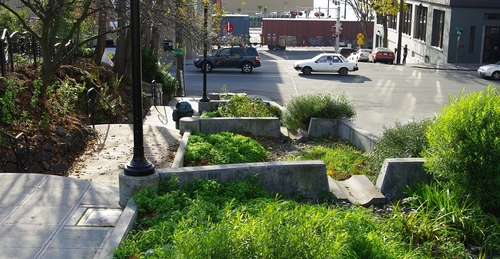It’s been a wild few days of weather – from spurts of hail to howling winds to shiny blue skies. While this cannot be completely attributed to climate change, it follows a trend of intensifying weather events. And it makes you wonder how the changing climate will affect our region.
We have some predictions already. Expect drier, hotter summers, like the record-breaking summer of 2017 that roasted many of GSP’s plants. Also brace for wetter, more extreme winters, which could mean more flooding and stormwater management issues. Uncertainty abounds, but we know that there will be challenges, especially for those who are already the most vulnerable.
Fortunately, we can do something about it. I got a glimpse of how last month at Sustainable Seattle’s 2018 Climate Resilience Summit. This meeting of minds from the nonprofit, government, academic, and business sectors highlighted a range of innovative projects that will equip the Pacific Northwest for the future.
What is Climate Resilience?
The Summit’s official definition is:
“the ability not only to bounce back, but to bounce forward – to recover and enhance the capacities of the community or organizations to better withstand future climate impacts”
A certain amount of climate change is inevitable. Loads of carbon dioxide already blanket the atmosphere, dirty power plants are still running, and cars are still guzzling. So while we must cut off the sources of ballooning carbon emissions, as organizations like 350.org and the Sierra Club are fighting to do, we must also prepare our communities to handle the impacts of a changing climate. To use two buzzwords, we need mitigation and adaptation. “Bouncing forward” means not only adapting to events such as increased flooding and reduced snowpack as they occur, but also proactively building our communities to flourish amid future climactic uncertainties. An important aspect of this “bounce forward” approach is that requires that we address issues often left out of climate change discourse – from public health and equity to public space.
The Projects
Projects presented that flesh out the theory and language behind climate resilience include:
- Green stormwater infrastructure designs from UW Landscape Architecture students. Inspired by Copehagen and Malmö, students gave a series of proposals to manage stormwater in Belltown. Examples include constructed wetlands (to hold and filter wastewater) near the former Alaskan Way ferry and up to 12 million gallons of nature-inspired water storage in the Battery Street Tunnel. As climate change brings increasingly volatile precipitation, we will need innovative ways to deal with all the water. These students show that we can do so effectively while delivering the co-benefits of urban greenery and public space.
- A GIS tool developed by King County that maps vulnerability to climate change across the county. With equity at the forefront, developers continue to tweak models of who will be affected by extreme weather and how they will respond. Preliminary research shows that South King County, disproportionately home to low-income and minority populations, is most at risk.
- The Yesler Terrace public housing redevelopment and its onsite urban farm. Representatives from Seattle Housing Authority and the Black Farmer’s Collective argued that building relationships among community members is essential to changing public policy, and that those relationships cannot be built without stable housing. Displacement – being priced out of your long-time home – erodes the social networks that are necessary for democracy and resilience. Farming is a powerful way to create these networks while also providing local food in the face of global crop uncertainty.
The Takeaway
From green infrastructure to open data to affordable housing, it takes an array of efforts to build a resilient region.
With these projects and others freshly in mind, summit participants then got the chance to talk with each other about collaboration within and across sectors. Of all that was said, the word to remember is “de-silo”. People used this term to describe looking beyond the artificial divisions that our hyper-specialized economy and grant application process create. Stepping back to share information and vision is easier said than done, but by no means impossible.
Green Seattle Partnership has a role to play in climate resilience, and so do you. We are strengthening nature’s infrastructure by restoring parks, building community networks by bringing neighbors together, and fostering collaboration through our partnership model. Please join us, and continue to challenge yourself, your community, and your representatives to build a resilient future.
Inspired? Come volunteer at your local park or learn more about climate resilience here or in the in-text links.




Jeb Polstein, thank you for this post. Its very inspiring.
Jeb Polstein,thanks so much for the post.Really thank you! Great.
Jeb Polstein, thank you ever so for you post.Much thanks again.